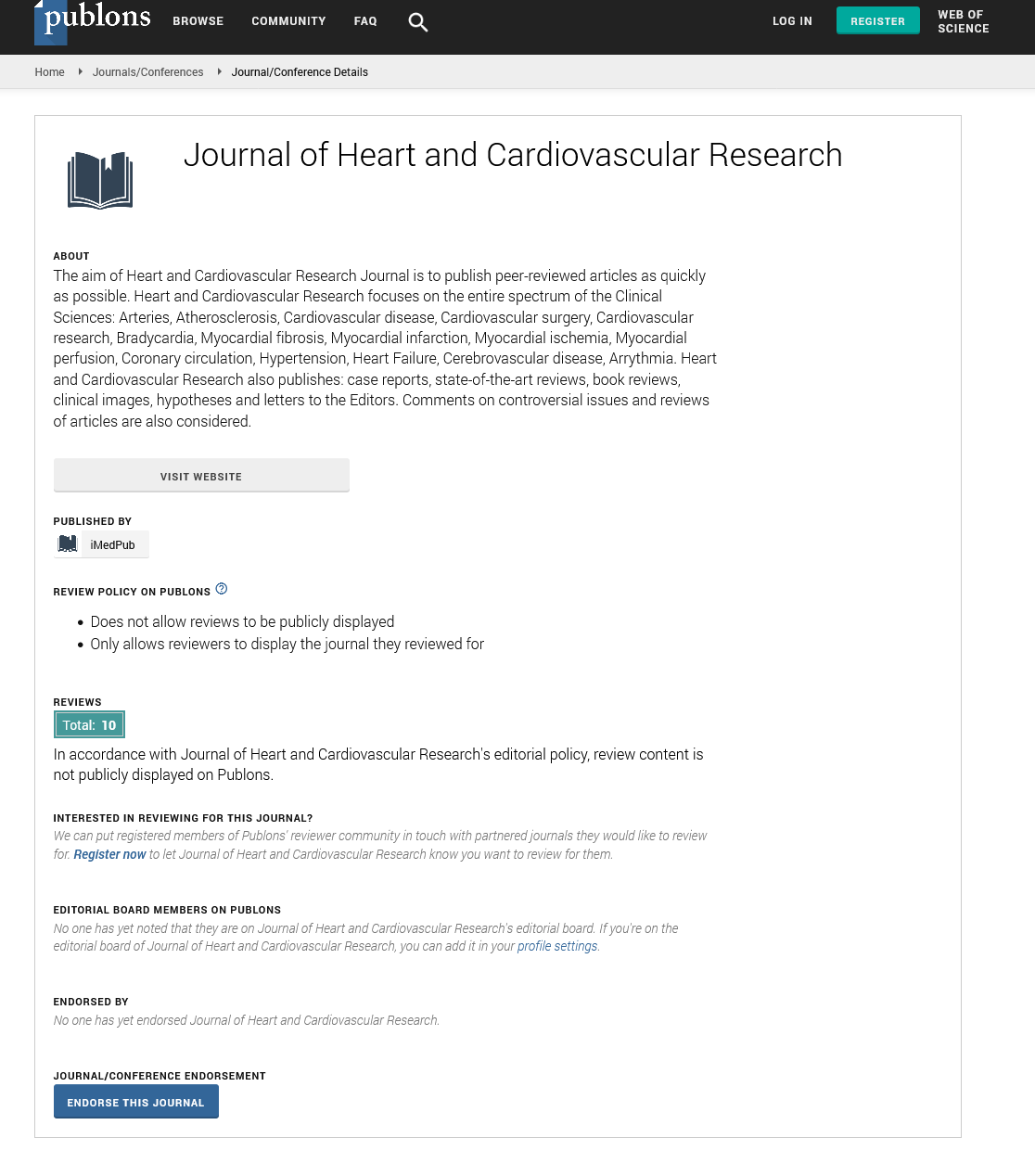ISSN : ISSN: 2576-1455
Journal of Heart and Cardiovascular Research
Abstract
Biventricular Function in Patients on Chronic Ventricular Pacing
Aim and objectives- There is indirect evidence from a large number of pacing mode selection trials and observational studies , that conventional right ventricular apical pacing may have detrimental effects on cardiac structure and left ventricular function, which are associated with the development of heart failure. There are limited studies with respect to right ventricular systolic and diastolic function in permanently paced patients. Hence it was proposed to study both LV and RV systolic and diastolic function in a population of permanently paced patients ,using standard echocardiographic techniques.
Methods- This study was a cross sectional study, with a sample size of 81 patients, who had undergone implantation of VVI pacemaker for at least a duration of 1 year.The control group comprised of patients who had pacemaker implanted in the atrial pacing mode,as well as patients with no structural heart disease and normal biventricular function selected from patients undergoing echo evaluation for screening before chemotherapy or surgery or for chest pain evaluation.Both groups were evaluated with standard echocardiographic parameters to assess both LV and RV systolic and diastolic function.
Results- LVEF(assessed by Simpson’s method)-was higher in the control group ( 70.6±4.2%) as compared to the paced group( 63.7±8.8%),but not of statistical significance (P =2.66) .LVPEP-The values in the paced patients were higher ( 104±16.67msecs) compared to the controls(87.8±3.3msecs), but not statistically significant(P=3.75). LVET- showed an increase in the paced group as compared to the control group(267.94±45.10) vs (284.49±40.03),the p value was significant(p=.02). LVPEP/LVET was increased in paced patients .The P value here was not significant (p=1.02.) LVIVRT-paced patients exhibited a higher value(107±19.47 msecs),than the control group(84.44±12.45 msecs), but was statistically insignificant. Mitral E/A-was decreased in the paced group(.9±.76) as compared to the controls(1.15±.40),this finding achieved statistical significance(p value=.02). Mitral E deceleration time-was prolonged (222.96±48.1msec) in the paced group compared to the controls( 203±49.2msec),this finding was statistically significant (p value=.01). Mitral E/E’ was increased in the paced group(9.23±3.08) vs controls(4.74±1.02),without statistical significance( p=2.45).
With regard to right ventricular systolic function, RVFAC(RV fractional area change ) was lower in the paced group( 46.56±9.17) compared to the control group(49.39±5.67), and this finding was statistically significant( p=.019). RVEF( Right ventricular ejection fraction)- was lower in the controls (43.09±3.31%) compared to the paced group, however this finding was statistically insignificant.(p=3.8). TAPSE( tricuspid annular plane systolic excursion)was increased in the paced group compared to the control group(22.96±4.4) vs 18.5±3.22mm) with no statistical significance(p=1.28). RVIVRT- right ventricular isovolumic relaxation time was increased in the paced group( 22.96±4.4) , compared to the control group(84.2±9.9)without attaining statistical significance( p=1.28). TRICUSPID PEAK E VELOCITY- was higher in the paced group( 62.45±14.64cm/s) compared to the control group(55.9±9.9cm/sec)achieving statistical significance (p=.001). TRICUSPID PEAK A VELOCITY - was greater in the control group(48.16±17.26 cm/sec vs 44.56±27.43cm/sec in the paced group), and was statistically insignificant. TRICUSPID E/A –was higher in the control group( 1.14±.380 vs paced group(.90±.5)and was statistically significant(p=.003). TRICUSPID E/A –was higher in the control group( 1.14±.380 vs paced group(.90±.5) and statistically significant(p=.003). TRICUSPID E/E’- was higher in the paced group( 5.45±2.15) compared to the controls ( 4.46±.848) and was statistically significant( p value of = .0001). Eccentricity index- was increased in the control group( 1.11±.07) compared to the paced group( 1.10±.08) without achieving statistical significance ( p=.46). SVC S/D FLOW- the ratio of systolic to diastolic flow in the SVC was increased in the paced group( 1.17±.34) compared to the control group( 1.06±.13), with statistical significance(p=.009).
Keywords- VVI Pacemaker,LV function,RV function,echocardiography.
Author(s): Vivek S Narayan Pillai
Abstract | Full-Text | PDF
Share This Article
Google Scholar citation report
Citations : 34
Journal of Heart and Cardiovascular Research received 34 citations as per Google Scholar report
Journal of Heart and Cardiovascular Research peer review process verified at publons
Abstracted/Indexed in
- Google Scholar
- Sherpa Romeo
- China National Knowledge Infrastructure (CNKI)
- Publons
Open Access Journals
- Aquaculture & Veterinary Science
- Chemistry & Chemical Sciences
- Clinical Sciences
- Engineering
- General Science
- Genetics & Molecular Biology
- Health Care & Nursing
- Immunology & Microbiology
- Materials Science
- Mathematics & Physics
- Medical Sciences
- Neurology & Psychiatry
- Oncology & Cancer Science
- Pharmaceutical Sciences
